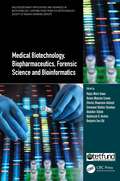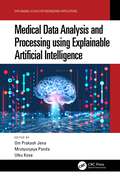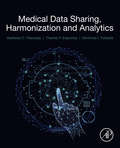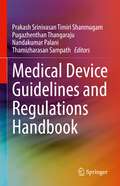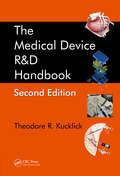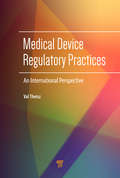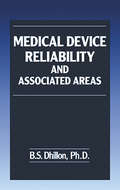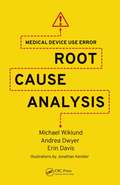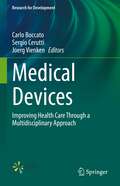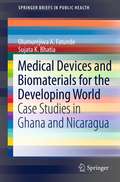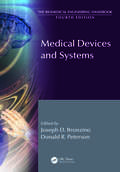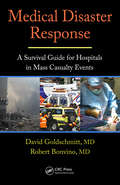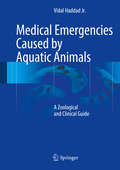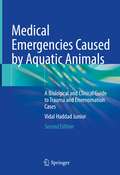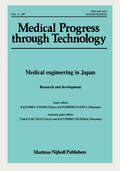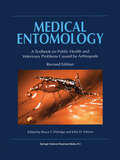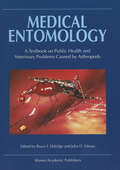- Table View
- List View
Medical Biochemistry: Human Metabolism in Health and Disease
by Miriam D. Rosenthal Robert H. GlewMetabolism includes various pathways of chemical reactions; understanding these pathways leads to an improved knowledge of the causes, preventions, and cures for human diseases. Medical Biochemistry: Human Metabolism in Health and Disease provides a concise yet thorough explanation of human metabolism and its role in health and diseases. Focusing on the physiological context of human metabolism without extensive consideration of the mechanistic principles of underlying enzymology, the books serves as both a primary text and resource for students and professional in medical, dental, and allied health programs.
Medical Biochemistry E-Book: With Student Consult Online Access
by John W Baynes Marek H. DominiczakBrought to you in a thorough yet accessible manner, the new edition of Medical Biochemistry gives access to all of the latest information on basic and clinically focused genetic and molecular biology. Featuring a team of contributors that includes investigators involved in cutting-edge research as well as experienced clinicians, this updated medical textbook offers a unique combination of both research and practice that's ideal for today's problem-based integrated courses.Consult this title on your favorite e-reader, conduct rapid searches, and adjust font sizes for optimal readability. Relate biochemistry to everyday practice with the help of Clinical Boxes integrated into the text, and access in-depth coverage of important topics - including recent research in biochemistry - through Advanced Concept Boxes.Test your knowledge and improve retention with Active Learning Boxes at the conclusion of each chapter, and quickly review the most common lab tests performed with convenient Clinical Test Boxes.Effectively study the most updated information in biochemistry with the help of a dynamic, full-color design.Better understand the relationship between science and clinical practice with material organized by organ rather than system. Gain a thorough understanding of biomarkers and their uses with brand-new information on the subject. Access today's most recent research regarding Gene Therapy, Proteomics and Recombinant DNA Techniques, Role of Kidney in Metabolism, and Neurochemistry.
Medical Biochemistry E-Book: With Student Consult Online Access
by John W Baynes Marek H. DominiczakNow fully revised, this acclaimed textbook efficiently links basic biochemistry with the day-to-day practice of medicine. You will learn basic science concepts and see them illustrated by clinical cases that describe patients you will likely encounter in your clinical training. You will also learn about the use of laboratory tests to diagnose and monitor the most important conditions. Brought to you in a thorough yet accessible manner, this new edition of Medical Biochemistry highlights the latest developments in regulatory and molecular biology, signal transduction, biochemistry and biomarkers of chronic disease, and bioinformatics and the ‘–omics’. It highlights the most important global medical issues: diabetes mellitus, obesity and malnutrition, cancer and atherosclerotic cardiovascular disease, and addresses the role of nutrition and exercise in medicine. Featuring a team of expert contributors that includes investigators involved in cutting-edge research as well as experienced clinicians, this book offers a unique combination of research and clinical practice tailored to today’s integrated courses. Read organ-focused chapters addressing the biochemistry of the bone, kidney, liver, lungs and muscle; and system-focused ones addressing the biochemistry of the immune and endocrine systems, neurochemistry and neurotransmission, and cancer
Medical BioMethods Handbook
by John M. Walker and Ralph RapleyJohn Walker and Ralph Rapley have collected a wide-ranging group of molecular and biochemical techniques that are the most frequently used in medical and clinical research, especially diagnostics. The authors-well-established investigators who run their own research programs and use the methods on a regular basis-outline the practical procedures for using them and describe a variety of pertinent applications. Among the technologies presented are southern and western blotting, electrophoresis, PCR, cDNA and protein microarrays, liquid chromatography, in situ hybridization, karyotyping, flow cytometry, bioinformatics, genomics, and ribotyping. The applications include assays for mutation detection, mRNA analysis, chromosome translocations, inborn errors of metabolism, protein therapeutics, and gene therapy.
Medical Biotechnology, Biopharmaceutics, Forensic Science and Bioinformatics (Multidisciplinary Applications and Advances in Biotechnology)
by Charles Oluwaseun Adetunji Emmanuel Olufemi Ekundayo Abubakar Gidado Abdulrazak B. Ibrahim Benjamin Ewa Ubi Hajiya Mairo Inuwa Ifeoma Maureen EzeonuThis book covers a range of topics on exploiting Nigeria’s mega biodiversity for food security and health; DNA forensic science and its applications; medical biotechnology and biopharmaceutics; medicinal and underutilized plants; impact and mitigation of antibiotic resistance; bioinformatics applications; medical insect biotechnology; etc. The book will be useful reference material for the scientists and researchers working in the fields of nutraceuticals, molecular diagnostics and DNA forensics, biopharmaceuticals and medical biotechnology, nanotechnology, antimicrobials from indigenous plant species, bioinformatics, etc. Emphasizes recent advances in biotechnologies that will help in tackling emerging global health challenges Provides detailed information on how to harness indigenous bioresources including microorganisms and plants for healthcare delivery Introduces new frontiers in the areas of molecular diagnostics and DNA forensic science and bioinformatics with case studies, recent advances in medical insect biotechnology and molecular genetics of pest use towards the exploitation of arthropod midgut components to develop interventions against infectious diseases Reviews bioactive molecules derived from commonly used and underutilized medicinal plants that could be used to develop novel drugs for improved healthcare delivery Discusses current approaches in medical and biopharmaceutical biotechnology, deployment of inexpensive genomics-based vector surveillance for effective disease outbreak prediction and control of mosquito-borne viruses Hajiya Mairo Inuwa, Ph.D., is Professor in the Department of Biochemistry and Formerly Director, Centre for Biotechnology Research and Training (CBR&T), Ahmadu Bello University, Zaria, Nigeria. Ifeoma Maureen Ezeonu, Ph.D., is Professor of Medical Microbiology and Molecular Genetics in the Department of Microbiology, University of Nigeria, Nsukka, Nigeria. Charles Oluwaseun Adetunji, Ph.D., is Associate Professor of Microbiology and Biotechnology and Director of Intellectual Property and Technology Transfer, Edo State University, Uzairue, Nigeria. Abubakar Gidado, Ph.D., is Professor of Biochemistry and Director of North-East Zonal Biotechnology Centre of Excellence at the University of Maiduguri. Emmanuel Olufemi Ekundayo, Ph.D., is Associate Professor of Medical Microbiology and Microbial Genetics, Michael Okpara University of Agriculture, Umudike, Nigeria. Abdulrazak B. Ibrahim, Ph.D., is a Capacity Development Expert at the Forum for Agricultural Research in Africa (FARA) and Associate Professor of Biochemistry, Ahmadu Bello University, Zaria, Nigeria. Benjamin Ewa Ubi, Ph.D., is a Professor of Plant Breeding and Biotechnology and Director, Biotechnology Research and Development Centre, Ebonyi State University, Abakaliki, Nigeria.
Medical Biotechnology, Biopharmaceutics, Forensic Science and Bioinformatics (Multidisciplinary Applications and Advances in Biotechnology)
by Hajiya Mairo InuwaThis book covers a range of topics on exploiting Nigeria’s mega biodiversity for food security and health; DNA forensic science and its applications; medical biotechnology and biopharmaceutics; medicinal and underutilized plants; impact and mitigation of antibiotic resistance; bioinformatics applications; medical insect biotechnology; etc. The book will be useful reference material for the scientists and researchers working in the fields of nutraceuticals, molecular diagnostics and DNA forensics, biopharmaceuticals and medical biotechnology, nanotechnology, antimicrobials from indigenous plant species, bioinformatics, etc. Emphasizes recent advances in biotechnologies that will help in tackling emerging global health challenges Provides detailed information on how to harness indigenous bioresources including microorganisms and plants for healthcare delivery Introduces new frontiers in the areas of molecular diagnostics and DNA forensic science and bioinformatics with case studies, recent advances in medical insect biotechnology and molecular genetics of pest use towards the exploitation of arthropod midgut components to develop interventions against infectious diseases Reviews bioactive molecules derived from commonly used and underutilized medicinal plants that could be used to develop novel drugs for improved healthcare delivery Discusses current approaches in medical and biopharmaceutical biotechnology, deployment of inexpensive genomics-based vector surveillance for effective disease outbreak prediction and control of mosquito-borne viruses Hajiya Mairo Inuwa, Ph.D., is Professor in the Department of Biochemistry and Formerly Director, Centre for Biotechnology Research and Training (CBR&T), Ahmadu Bello University, Zaria, Nigeria. Ifeoma Maureen Ezeonu, Ph.D., is Professor of Medical Microbiology and Molecular Genetics in the Department of Microbiology, University of Nigeria, Nsukka, Nigeria. Charles Oluwaseun Adetunji, Ph.D., is Associate Professor of Microbiology and Biotechnology and Director of Intellectual Property and Technology Transfer, Edo State University, Uzairue, Nigeria. Abubakar Gidado, Ph.D., is Professor of Biochemistry and Director of North-East Zonal Biotechnology Centre of Excellence at the University of Maiduguri. Emmanuel Olufemi Ekundayo, Ph.D., is Associate Professor of Medical Microbiology and Microbial Genetics, Michael Okpara University of Agriculture, Umudike, Nigeria. Abdulrazak B. Ibrahim, Ph.D., is a Capacity Development Expert at the Forum for Agricultural Research in Africa (FARA) and Associate Professor of Biochemistry, Ahmadu Bello University, Zaria, Nigeria. Benjamin Ewa Ubi, Ph.D., is a Professor of Plant Breeding and Biotechnology and Director, Biotechnology Research and Development Centre, Ebonyi State University, Abakaliki, Nigeria.
Medical Data Analysis and Processing using Explainable Artificial Intelligence (Explainable AI (XAI) for Engineering Applications)
by Om Prakash Jena Mrutyunjaya Panda Utku KoseThe text presents concepts of explainable artificial intelligence (XAI) in solving real world biomedical and healthcare problems. It will serve as an ideal reference text for graduate students and academic researchers in diverse fields of engineering including electrical, electronics and communication, computer, and biomedical. Presents explainable artificial intelligence (XAI) based machine analytics and deep learning in medical science. Discusses explainable artificial intelligence (XA)I with the Internet of Medical Things (IoMT) for healthcare applications. Covers algorithms, tools, and frameworks for explainable artificial intelligence on medical data. Explores the concepts of natural language processing and explainable artificial intelligence (XAI) on medical data processing. Discusses machine learning and deep learning scalability models in healthcare systems. This text focuses on data driven analysis and processing of advanced methods and techniques with the help of explainable artificial intelligence (XAI) algorithms. It covers machine learning, Internet of Things (IoT), and deep learning algorithms based on XAI techniques for medical data analysis and processing. The text will present different dimensions of XAI based computational intelligence applications. It will serve as an ideal reference text for graduate students and academic researchers in the fields of electrical engineering, electronics and communication engineering, computer engineering, and biomedical engineering.
Medical Data Analysis and Processing using Explainable Artificial Intelligence (Explainable AI (XAI) for Engineering Applications)
by Om Prakash Jena Mrutyunjaya Panda Utku KoseThe text presents concepts of explainable artificial intelligence (XAI) in solving real world biomedical and healthcare problems. It will serve as an ideal reference text for graduate students and academic researchers in diverse fields of engineering including electrical, electronics and communication, computer, and biomedical. Presents explainable artificial intelligence (XAI) based machine analytics and deep learning in medical science. Discusses explainable artificial intelligence (XA)I with the Internet of Medical Things (IoMT) for healthcare applications. Covers algorithms, tools, and frameworks for explainable artificial intelligence on medical data. Explores the concepts of natural language processing and explainable artificial intelligence (XAI) on medical data processing. Discusses machine learning and deep learning scalability models in healthcare systems. This text focuses on data driven analysis and processing of advanced methods and techniques with the help of explainable artificial intelligence (XAI) algorithms. It covers machine learning, Internet of Things (IoT), and deep learning algorithms based on XAI techniques for medical data analysis and processing. The text will present different dimensions of XAI based computational intelligence applications. It will serve as an ideal reference text for graduate students and academic researchers in the fields of electrical engineering, electronics and communication engineering, computer engineering, and biomedical engineering.
Medical Data Sharing, Harmonization and Analytics
by Vasileios Pezoulas Themis Exarchos Dimitrios I FotiadisMedical Data Sharing, Harmonization and Analytics serves as the basis for understanding the rapidly evolving field of medical data harmonization combined with the latest cloud infrastructures for storing the harmonized (shared) data. Chapters cover the latest research and applications on data sharing and protection in the medical domain, cohort integration through the recent advancements in data harmonization, cloud computing for storing and securing the patient data, and data analytics for effectively processing the harmonized data. Examines the unmet needs in chronic diseases as a part of medical data sharingDiscusses ethical, legal and privacy issues as part of data protectionCombines data harmonization and big data analytics strategies in shared medical data, along with relevant case studies in chronic diseases
Medical Device Guidelines and Regulations Handbook
by Prakash Srinivasan Timiri Shanmugam Pugazhenthan Thangaraju Nandakumar Palani Thamizharasan SampathThis comprehensive resource features in-depth discussions of important guidelines and regulations needed to understand and properly meet medical device code-related requirements. Focusing on the practical application of the regulations, the Medical Device Guidelines and Regulations Handbook delivers clear explanations, real-world examples, and annotation on the applicable provisions that will allow you to safely and confidently choose materials and processes for medical device development, testing, and manufacturing. A critical resource for researchers and professionals in the medical device field;Thoroughly covers ISO 10993, ISO 22442, ISO 14971, ISO 13485, ISO 21534, REACH, RoHS, CLP, EU MDR;Presents simplified guidelines and regulation points.
The Medical Device R&D Handbook
by Theodore R. KucklickExploring the practical, entrepreneurial, and historical aspects of medical device development, this second edition of The Medical Device R&D Handbook provides a how-to guide for medical device product development. The book offers knowledge of practical skills such as prototyping, plastics selection, and catheter construction, allowing designer
Medical Device Regulatory Practices: An International Perspective
by Val TheiszThis book is intended to serve as a reference for professionals in the medical device industry, particularly those seeking to learn from practical examples and case studies. Medical devices, like pharmaceuticals, are highly regulated, and the bar is raised constantly as patients and consumers expect the best-quality healthcare and safe and effectiv
Medical Device Reliability and Associated Areas
by B.S. DhillonAlthough Reliability Engineering can trace its roots back to World War II, its application to medical devices is relatively recent, and its treatment in the published literature has been quite limited. With the medical device industry among the fastest growing segments of the US economy, it is vital that the engineering, biomedical, manufacturing,
Medical Device Use Error: Root Cause Analysis
by Michael Wiklund Andrea Dwyer Erin DavisMedical Device Use Error: Root Cause Analysis offers practical guidance on how to methodically discover and explain the root cause of a use error-a mistake-that occurs when someone uses a medical device. Covering medical devices used in the home and those used in clinical environments, the book presents informative case studies about the use errors
Medical Devices: Improving Health Care Through a Multidisciplinary Approach (Research for Development)
by Sergio Cerutti Carlo Boccato Joerg VienkenThis book provides caregivers and administrators with high-quality support for strategic decision making in the selection and use of medical devices so as to ensure value optimization. Medical treatment is increasingly complex, with wide application of medical devices and corresponding involvement of physics and engineering. A multidisciplinary methodology that brings together expertise from key disciplines in a holistic, system-oriented approach is essential in controlling this complexity and further improving health care. This book will help readers to understand the design, validation, and application of medical devices and the standards and regulations that apply to them across the world. In addition, it provides technical, operational, and economic perspectives on their use. The relevance of concepts such as expenditure optimization and sustainability to medical device technology is explained and healthcare reimbursement systems are discussed from different points of view. Readers will gain a clear appreciation of the managerial and economic implications of the use of medical devices and how to get the most out of them. Academic research, industrial experiences, and case studies are presented as appropriate.
Medical Devices: Surgical and Image-Guided Technologies
by Martin Culjat Rahul Singh Hua LeeAddressing the exploding interest in bioengineering for healthcare applications, this book provides readers with detailed yet easy-to-understand guidance on biomedical device engineering. Written by prominent physicians and engineers, Medical Devices: Surgical and Image-Guided Technologies is organized into stand-alone chapters covering devices and systems in diagnostic, surgical, and implant procedures. Assuming only basic background in math and science, the authors clearly explain the fundamentals for different systems along with such topics as engineering considerations, therapeutic techniques and applications, future trends, and more. After describing how to manage a design project for medical devices, the book examines the following: Instruments for laparoscopic and ophthalmic surgery, plus surgical robotics Catheters in vascular therapy and energy-based hemostatic surgical devices Tissue ablation systems and the varied uses of lasers in medicine Vascular and cardiovascular devices, plus circulatory support devices Ultrasound transducers, X-ray imaging, and neuronavigation An absolute must for biomedical engineers, Medical Devices: Surgical and Image-Guided Technologies is also an invaluable guide for students in all engineering majors and pre-med programs interested in exploring this fascinating field.
Medical Devices: Surgical and Image-Guided Technologies
by Martin Culjat Rahul Singh Hua LeeAddressing the exploding interest in bioengineering for healthcare applications, this book provides readers with detailed yet easy-to-understand guidance on biomedical device engineering. Written by prominent physicians and engineers, Medical Devices: Surgical and Image-Guided Technologies is organized into stand-alone chapters covering devices and systems in diagnostic, surgical, and implant procedures. Assuming only basic background in math and science, the authors clearly explain the fundamentals for different systems along with such topics as engineering considerations, therapeutic techniques and applications, future trends, and more. After describing how to manage a design project for medical devices, the book examines the following: Instruments for laparoscopic and ophthalmic surgery, plus surgical robotics Catheters in vascular therapy and energy-based hemostatic surgical devices Tissue ablation systems and the varied uses of lasers in medicine Vascular and cardiovascular devices, plus circulatory support devices Ultrasound transducers, X-ray imaging, and neuronavigation An absolute must for biomedical engineers, Medical Devices: Surgical and Image-Guided Technologies is also an invaluable guide for students in all engineering majors and pre-med programs interested in exploring this fascinating field.
Medical Devices and Biomaterials for the Developing World: Case Studies in Ghana and Nicaragua (SpringerBriefs in Public Health)
by Olumurejiwa A. Fatunde Sujata K. BhatiaThis book focuses on the adoption of medical technology in the developing world, and the role that can be played by new biomaterials. These authors urge that advanced technology be aligned with the needs of developing and emerging markets, and an alternative definition of technology be embraced. This “new technology” considers natural sources of materials and tools for treatment and is not restricted to the usual traditional computerized or electronic technology. This book explores the difficulties that accompany successful transfer of technologies between disparate settings. The book then leaves the world of traditional technology and focuses on biomaterials, which represent an enormous opportunity for developing societies to become active participants in the development of new technologies. Biomaterials can be used in the treatment of disease throughout the developing world and beyond. Biomaterials encompass a range of naturally derived substances; of particular interest here are naturally derived and synthetically manufactured materials with potential applications in different body systems. Because many of these materials can be grown, the agricultural output of developing nations is an obvious potential source of these biomaterials. The book considers the cases of Ghana and Nicaragua as examples of the broader situation in West Africa and Central/South America. These two regions are uniquely positioned with regard to both health care and technological capabilities, and both stand to grow significantly in the coming years. While the agricultural sectors of the two nations are quite different, both are major producers of corn and other materials that should be investigated further. Of course, the difficulty in using a foodstuff for medical purposes is fully explored.
Medical Devices and Human Engineering (The Biomedical Engineering Handbook, Fourth Edition)
Known as the bible of biomedical engineering, The Biomedical Engineering Handbook, Fourth Edition, sets the standard against which all other references of this nature are measured. As such, it has served as a major resource for both skilled professionals and novices to biomedical engineering. Medical Devices and Human Engineering, the second volume of the handbook, presents material from respected scientists with diverse backgrounds in biomedical sensors, medical instrumentation and devices, human performance engineering, rehabilitation engineering, and clinical engineering. More than three dozen specific topics are examined, including optical sensors, implantable cardiac pacemakers, electrosurgical devices, blood glucose monitoring, human–computer interaction design, orthopedic prosthetics, clinical engineering program indicators, and virtual instruments in health care. The material is presented in a systematic manner and has been updated to reflect the latest applications and research findings.
Medical Disaster Response: A Survival Guide for Hospitals in Mass Casualty Events
by David Goldschmitt Robert BonvinoWhile the job of a clinician in a disaster scenario is to save lives without regard for the cause or rationale for the injury, medical and emergency professionals who understand the diverse aspects of a disaster are better equipped to respond effectively. Giving emergency personnel the tools they need to perform in catastrophic situations, Medical
Medical Emergencies Caused by Aquatic Animals: A Zoological and Clinical Guide
by Vidal Haddad JrThe present book is intended as a reference guide for emergency and ambulatory care medicine, providing essential information on the most important problems and incidents caused by venomous, poisoning and traumatic marine and freshwater animals. Indeed, though emergencies caused by aquatic animals are becoming increasingly common, there are few reference books devoted to providing medical guidance on them. The book includes a wealth of original images of injuries caused by aquatic animals, while the text covers the current state knowledge on the subject, including the identification of the animals, the clinical aspects of the envenomation/poisonings/injuries, first aid and emergency care, main treatment alternatives and a typical case representing each group of animals. Chapters are organized according to zoological groups: Marine and Freshwater Invertebrates (Porifera, Cnidarians, Annelida, Mollusks, Echinodermata) and Marine and Freshwater Vertebrates (Fish and Reptiles). Medical Emergencies Caused By Aquatic Animals: A Zoological and Clinical Guide is intended for students and professionals in Medicine (Dermatology, Tropical Medicine, Infectious Diseases and Emergency Medicine) and the Biological Sciences (Zoology and Ecology), as well as to practicing professionals working in coastal or freshwater areas.
Medical Emergencies Caused by Aquatic Animals: A Biological and Clinical Guide to Trauma and Envenomation Cases
by Vidal Haddad JuniorThis is the second edition of the book originally published under the title Medical Emergencies Caused by Aquatic Animals: A Zoological and Clinical Guide. Including updated chapters, new content and additional references, it discusses follow-up with patients, describes diseases that are not emergencies and explains procedures that can take place at health stations and outpatient centers, focusing on clinical and biological aspects relevant to researchers and practitioners alike. The chapter on Invertebrate Aquatic Animals presents facts and advances that were left out of the first edition. In addition, it includes improved images. The subtopic on Cnidaria presents recent data on outbreaks and new species identification in unprecedented areas, with a timely discussion on first aid treatment. The chapter on Injuries by Vertebrate Aquatic Animals has been improved, based on continued work with bathers and fishermen. Featuring numerous images and representative clinical cases, it explores the most significant injuries caused by fish around the globe. The chapter on Ingestion of Aquatic Venomous Animals: Toxinology, Clinical Aspects, and Treatment discusses outbreaks of intoxication diseases from eating fish and seafood, drawing on reliable records of serial cases of Haff's syndrome, scombroidism and ciguatera. Further, it examines the indiscriminate consumption of aquatic animals, which the author argues present the same (or even greater) risks of poisoning and infections as terrestrial animals. Lastly, since there is a general lack of awareness of the risk of infections in aquatic environments, the chapter on Bacterial and Fungal Infections in Aquatic Environments describes the symptoms and treatments and highlights preventive measures.
Medical engineering in Japan: Research and development
by K. Atsumi F. KajiyaThe complete volume 12 of Medical Progress through Technology is devoted to the work of colleagues in Japan. Additionally, whole authority and responsibility both for the election of topics and for the reviewing procedure had been delegated to Guest Editors from Japan. What are the objectives of this special issue and why has Japan been elected to present itself in this way? International journals such as Medical Progress through Technology usually contain papers from authors all over the world. Such issues provide a rather comprehensive survey on different scientific projects but do not reflect the standard and extent of medical technology in a certain country. I think that issues like the present one give far better information on the actual state of research and development in a country than an irregular sequence of scientific reports. It is not intended that all future issues of Medical Progress through Technology will concern only national issues. The present issue is an exception. However, if the readers appreciate such an approach, then other national issues may be published. There are several reasons in favor of Japan preparing the first national issues. We all admire the history, tradition and culture of this country, but we are also impressed by the high standard of research, develop ment and technical realisation achieved in nearly all high technology fields. There is no doubt, that Japan is among the leading nations in the field of medical technology.




